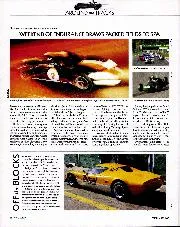
Off the blocks
Though best known for Formula Ford chassis, the Dulon marque also ventured into sportscars, and its 1969 GT coupe has just returned to the track after 30 years away. Badged…
SAFETY-FIRST AND THE MODERN CAR
Nowadays we are being constantly reminded of the importance of “safetyfirst,” and our wireless sets inform us at not infrequent intervals of how grave is the toll of the road.
So often road accidents are attributed to the ever-increasing volume of traffic on our highways and to the great speed capabilities of modern cars. How many people ever pause to consider the srifety factors possessed by the present-day motor-Car, and how these factors not only help in the avoidance of innumerable accidents that would otherwise occur through the negligence of cyclists and pedestrians, but actually assist materially in the easy rapid flow of the traffic stream, over roads inadequate to the passage of so Many Vehicles as they now carry ?
In the first place just think of the time saved by rapid acceleration out of builtup 30 m.p.h. areas. Cars of ten years ago had nothing like as effective pick-up as present-day productions, and severe congestion Would have resulted in many areas where short closely-grouped .” built-up ” sections now abound. Again many of the by-pass roads around London are insufficiently wide for the safe flow of fast traffic and it is only the powerful braking, good steering, and accurate control of present-day cars that permits of high-speed travel in close company, and allows these roads to carry a reasonable quantity and volume of traffic.
Out on the open road, away from large towns, the congestion question is of lesser Moment, and it might even be said that the much increased cruising speed of even the cheapest family cars constitutes a danger factor. Nevertheless, the improved qualities of control, the greater reliability of lighting equipment and especially the now almost universal provision of satisfactory anti-dazzle arrangements, combine very strongly to cancel out danger resulting from time use of increased Cruising speeds by careless and incompetent drivers. In town driving the modern car
shows up equally well Traffic lights must change at very ‘short intervals if they are to control traffic efficiently at busy intersections. It is doubtful if they would have proved practical on a widespread scale if the majority of us still had to rely upon rear-wheel brakes, and small section high-pressure tyres !
A general improvement in the ease and simplicity of car control, attributable to light low-geared steering, synchro-mesh gearchange, semi-servo brakes, automatically ” zero’d ” direction indicators, and so on, has enabled the frailest lady driver to take her place with confidence in the thickest and fastest traffic stream. Ice-bound roads, certainly, still call for care, but rain no longer holds any terrors for the driver of a modern car
possessing scientifically-treaded tyres of ample section, a proper distribution of weight, and smooth correctly-equalised braking. Car equipment itself can contribute very materially to safer motoring. Just imagine motoring any distance On a wet moonless night with dim oldfashioned lamps and no screen-wiper !
This progress in car design and equipment is portrayed not only in the economic use of roads, but also in the confidence with which the present-day driver sets out on really lengthy journeys. Road space is conserved by traffic flowing at high speed in close company, while the longest journeys are completed in comfort and security because the modern car is effortless to control) and free from the possibility of involuntary stoppages. If manufacturers have increased the cruising and maximum speed of their productions, no one can accuse them of failing to develop safety factors in more than adequate proportion. With lightless cyclists, foolish walkers, inky road surfaces, and old-fashioned roadbuilding, it is indeed fortunate that our
cars are generally so foolproof. The modern motor-car is a remarkably responsive piece of mechanism ; let us be certain that we make full use of its capabilities, with particular reference to those safetyfirst factors !